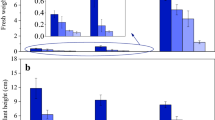Abstract
Greenhouse and laboratory studies were conducted to evaluate the toxic effects of Be and V on collards (Brassica oleracea, var. acephala L.). In the laboratory germination study, incremental increases in the Be concentrations of the growing medium induced a steady decline in the radicle length of seven-day-old collard seedling. Beryllium concentrations greater than or equal to 8 mg Be L−1 totally inhibited seed germination. The presence of V in the growing medium had no effect on collard germination; however, it had a profound effect on subsequent radicle elongation. Concentrations of V less than 1 mg V L−1 stimulated radicle elongation, while concentrations greater than or equal to 3 mg V L−1 caused severe toxicity. In the greenhouse study, Be toxicity was observed in collards grown in a Blanton sand (Grossarenic Paleudult) received treatments greater than or equal to 150 mg Be kg −1 (as BeSO4). Irrespective of treatment level, 97% of the Be taken up by the plants remained in the roots while only 3% was translocated to aboveground plant parts. Vanadium tissue concentrations and toxicity to collards varied with soil type. Additions as low as 80 mg V kg−1 to the Blanton sand significantly reduced collard biomass while additions as high as 100 mg V kg−1 to an Orangebury loamy sand (Typic Paleudult) had no effect on plant biomass. The differential response was attributed to greater accumulation of V by plants grown in the Blanton soil.
Similar content being viewed by others
References
Adamu, C. A., Bell, P. F., Mulchi, C., and Chaney, R.: 1989, Environ. Pollut. 56, 113.
Adriano, D. C.: 1986, in Trace Elements in the Terrestrial Environment, Springer-Verlag, Inc. New York, p. 470.
Alley, M. M., Martens, D. C., Schnappinger, Jr., M. G., and Hawkins, G. W.: 1972. Soil Sci. Soc. Am. Proc. 36, 621.
Arnon, D. I. and Wessell, G.: 1953, Nature 172, 1039.
Barbarick, K. A. and Workman, S. M.: 1987, J. Environ. Qual. 16, 125.
Basiouny, F. M.: 1984, J. Plant Nutr. 7, 1059.
Baxter, J. C., Aguilar, M., and Brown, K.: 1983, J. Environ. Qual. 12, 311.
Brosset, C. 1976, Ambio 5, 157–163.
Cannon, H. L.: 1963, Soil Sci. 96, 196.
Carlson, C. L., Kaplan, D. I., and Adriano, D. C.: 1989, Environ. Exp. Bot. 29, 493.
Council on Soil Testing and Plant Analysis: 1980, Handbook on reference Methods for Soil Testing, Univ. of Georgia, Athens, GA, p. 231.
Hopkins, L. L. and Mohr, H. E.: 1974, Fed. Proc. 33, 1773.
Jones, Jr., J. B.: 1988, Soil Testing and Plant Analysis: Procedures and Use. Food and Fertilizer Technology Center. Tech. Bull. Univ. Georgia. No. 109.
Kabata-Pendias, A. and Pendias, H.: 1984, Trace Elements in Soils and Plants, CRC Press Inc. Boca Raton, FL.
Kaplan, D. I., Adriano, D. C., Carlson, C. L., and Sajwan, K. S.: 1990, Water, Air and Soil Pollut. 49, 81.
Korte, N. E., Skopp, J., Fuller, W. H., Niebla, E. E., and Alesii, B. A.: 1976, Soil Sci. 122, 350.
Lepp, N. W.: 1977, Z Pflanzen. Bd. 83, 185.
Lindsay, W. L. and Norvell, W. A.: 1978, Soil Sci. Soc. Am. J. 24, 421.
Mehlich, A.: 1984, Commun. Soil Sci. Plants Anal. 15, 1409.
Nicholas, D. J. D.: 1975, ‘The Functions of Trace Elements in Plants’, in D. J. D. Nicholas, and A. R. Egan (ed.), Trace Elements in Soil-Plant-animal Systems, Academic Press, New York, p. 181.
O'Connor, G. A.: 1988, J. Environ. Qual. 17, 715.
Peterson, P. J. and Girling, C. A.: 1981, ‘Other Trace Metals’, in N. W. Lepp (ed.), Effect of Heavy Metal Pollution on Plants. Vol. 1: Effects of Trace Metals on Plant Function, Applied Science Publ., London, p. 212.
Puerner, N. J. and Siegel, S. M.: 1972, Physiol. Plant 26, 310.
Romney, E. M. and Childress, J. D.: 1965, Soil Sci. 100, 210.
Silviera, D. J. and Sommers, L. E.: 1977, J. Environ. Qual. 6, 47.
Street, J. J., Lindsay, W. L., and Sabey, B. R.: 1977, J. Environ. Qual. 6, 72.
Weiguo, Q.: 1983, Anal. Chem. 55, 2043.
Williams, R. J. B. and Le Riche, H. H.: 1968, Plant Soil 29, 317.
Zenz, C.: 1980, ‘Vanadium’, in H. A. Waldron (ed.), Metals in the Environment, Academic Press, New York, p. 293.
Zoller, W. H., Gladney, E. S., Gordon, G. E., and Bors, J. J.: 1974, Trace Subs. Environ. Health 8, 167.
Zubovic, P.: 1969, ‘Coal Emissions of Beryllium’, in Proc. of Beryllium Conference, MIT, Cambridge, Mass., U.S.A.
Author information
Authors and Affiliations
Additional information
Author for all correspondence.
Rights and permissions
About this article
Cite this article
Kaplan, D.I., Sajwan, K.S., Adriano, D.C. et al. Phytoavailability and toxicity of beryllium and vanadium. Water Air Soil Pollut 53, 203–212 (1990). https://doi.org/10.1007/BF00170737
Received:
Revised:
Issue Date:
DOI: https://doi.org/10.1007/BF00170737




